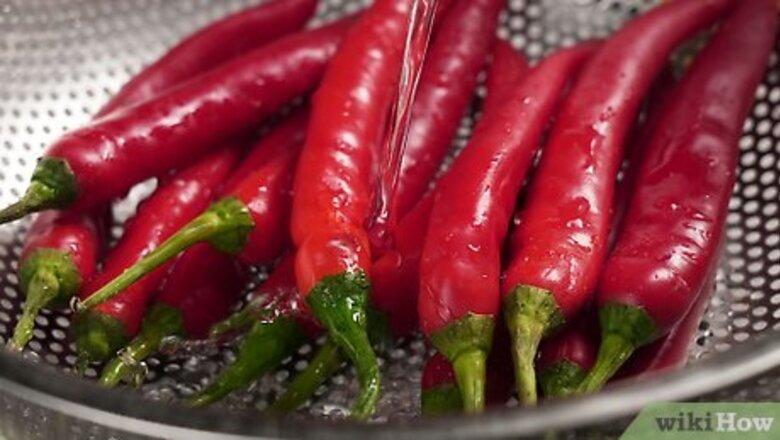
views
Drying Chilies
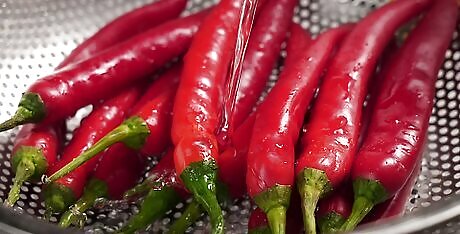
Wash and dry your chilies. Rinse them under cool running water, taking care to wash away dirt and other debris. Pick out bruised or damaged chilies, since these won't keep for long periods of time. Pat the chilies dry with a paper towel before proceeding. You might want to wear gloves to protect your hands as you handle the chilies. Hot chili peppers contain capsaicin, a chemical that burns when it gets on your skin. Take special care not to touch your eyes or nose after handles hot chilies.
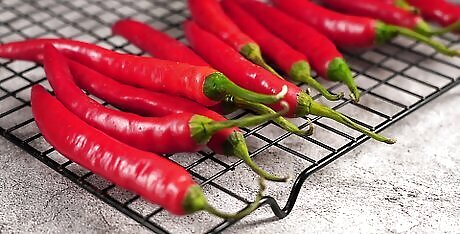
Lay them out on a wire rack. You can use a cooling rack or another rack that has vents to allow air circulation from below. If possible, avoid using a solid cooking sheet or tray, since the lack of air flow will make it more difficult for the peppers to dry evenly. Put the tray in a sunny, well-ventilated room. The kitchen windowsill is a great spot. Let them dry for three or more days, then store them in an airtight container.
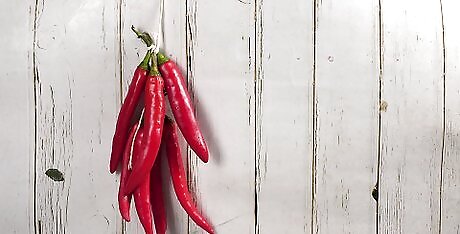
Try stringing and hanging the chilies. This is an easy and decorative way to dry them. Once the chilies are dry, you can keep them hanging up or store them for later use. Here's how to do it: Thread a needle with a long piece of strong thread or fishing line. Pierce the chilies just under their caps to thread the needle through them. Do this until all of the chilies have been threaded. Hang them in a well ventilated and sunny place in your home. In three days to a week, they’ll be dry and ready to use.
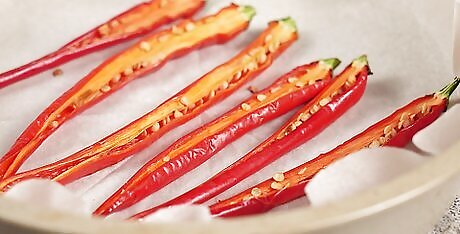
Oven dry the chilies. This is a good technique if you can't wait days, and don't want to wait for the chilies to dry out naturally. Instead of keeping the chilies whole, slicing them helps them dry evenly and quickly. Follow these simple steps: Slice the cleaned chilies in half lengthwise. Lay them seed-side up on a baking sheet. Bake at 125 °F (51.7 °C) (or your lowest setting) for several hours. This is still a lengthy process but quicker than air drying. You could also use a food dehydrator for quick results.
Pickling Chilies
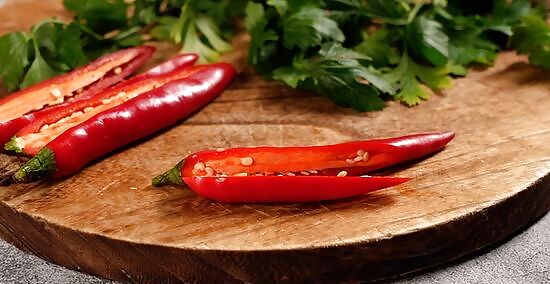
Wash and slice the chilies. It's not completely necessary You may quarter them or slice them lengthwise. If you prefer to preserve the chilies whole, use a knife to make a small slit in the side of each chile, which helps to preserve the shape. Depending on how hot you want your pickled chiles to be, you can remove the seeds or keep them.
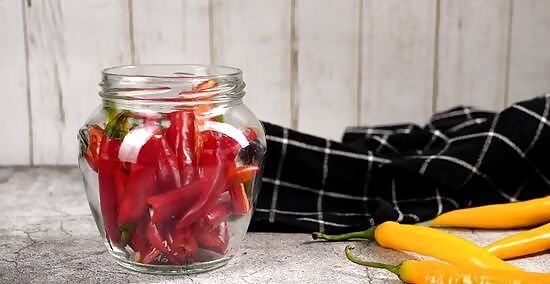
Pack the chilies in a sterilized jar. Choose a clean canning jar and fill it to within an inch of the rim with chiles. Make sure the jar has a tight-fitting lid. Plastic is preferable, since it won't rust in the refrigerator. If you want to flavor the chilies, mix in three tablespoons of salt and 15 peppercorns before packing the chilies. This will lend the chilies a flavor similar to that of pickled jalapeño served in restaurants. Other spices, such as bay leaves or fresh herbs, can also be added to the mixture to flavor the peppers.
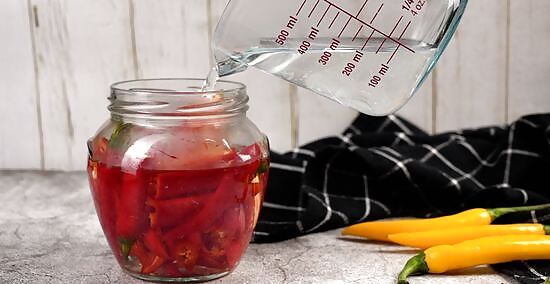
Heat white vinegar to a low boil. Use about two cups of vinegar, or enough to pour into the jar and cover the peppers completely. When the vinegar is hot, Pour the hot vinegar over the peppers. Fill the jar to within about half an inch of the top. If you want the peppers to have a sweet flavor, dissolve six teaspoons of sugar into the vinegar. Let the contents of the jar cool for a few minutes.

Store in the refrigerator. The longer you let the mixture sit, the stronger the pickled taste will get. Enjoy the pickled peppers as a side dish or on sandwiches. The spicy vinegar makes an excellent salad dressing.
Freezing Chilies

Wash the chilies. Discard any damaged chilies, since they won't keep well in the freezer. Fresh chilis will last about a week in the refrigerator, but you can keep them indefinitely in the freezer.
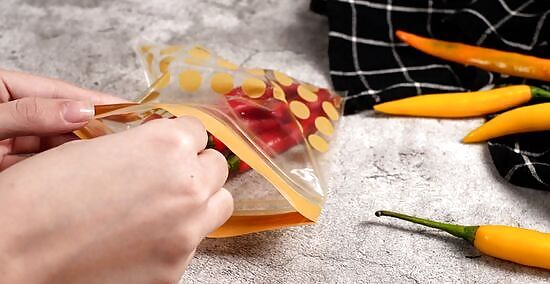
Freeze small peppers whole. If you have small peppers that you'd like to freeze whole, you can simply put them in a freezer bag. Use a straw to suck out the excess air, then seal and label the bag before placing it in the freezer. Pack the bag as tightly as possible, so there's little extra air in the bag. Air will make the peppers spoil faster. When you want to use the peppers, simply leave them out to thaw or blanch them in boiling water for a few seconds.
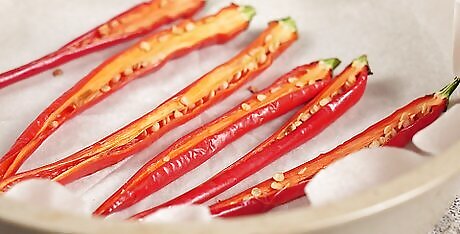
Freeze large peppers in strips. Bigger peppers can be sliced into strips or chunks you can easily use in a recipe later on. Slice them lengthwise or into chunks and remove the seeds. Lay the pieces on a baking sheet and freeze them for an hour. This is called flash freezing. Put the pieces in a storage bag and remove the extra air. Store in the freezer for up to several months.
Preserving Chilies in Olive Oil
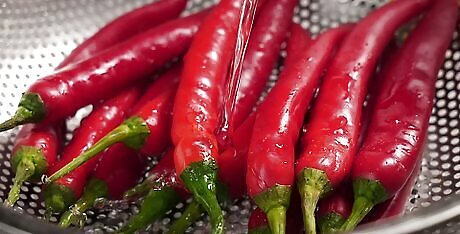
Wash and slice the chilies. To prepare chilies for preservation in oil, most people slice them into strips. However, smaller chilies may be left whole. Leave in as many seeds as you want depending on the heat level you desire. Lay them out on a baking sheet in a single layer.
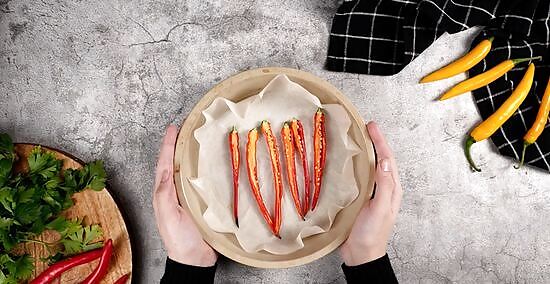
Broil the pepper pieces. Cooking the chilies before preserving them will help to bring out the best in their flavor. You can roast them over a grill or a gas burner. Preheat your oven's broil, or prepare your grill. Roast the slices until they’re charred. Under the broiler, this should take just a few minutes. Turn them once during the process so they cook evenly on all sides.
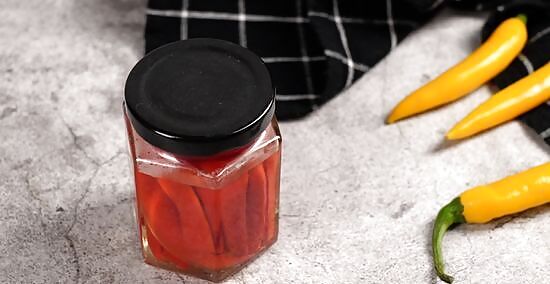
Pack the peppers in olive oil. Put the peppers in a clean jar or bottle. You may want to use a decorative olive oil container. Pour olive oil over the peppers until they're entirely covered. Store the jar in a cool, dark place.


















Comments
0 comment